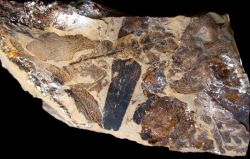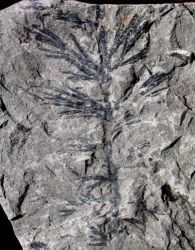Seed ferns from Yorkshire
Click on the photos for more information..
The seed ferns carried on for a long time after the major extinction
at the end of the Permian, though in modest numbers. The last ones died out
in the Cretaceous. Seed ferns often had a thick cuticle, which has been preserved
on the fossils as a thick coaly layer.
Several groups of seed ferns have been discovered in the Yorkshire area.
Most famous are the Caytoniales (named after Cayton Bay). The reason of this
celebrity is that for a long time it has been thought that they were ancestors
of the modern flowering plants (the angiosperms). An indication for this
idea was the reticulate venation of the leaves. Since then this has turned
out not to be the case.
 The
leaves of the plants from this group are assigned to the genus
Sagenopteris. A leaf is composed of (mostly) four leaflets sitting
on top of a petiole. A complete leaf is very rare but the detached leaflets
are rather common. The elongated form and the reticulate venation make
identification easy. In Cayton Bay the species Sagenopteris philipsii
is the most common one.
The
leaves of the plants from this group are assigned to the genus
Sagenopteris. A leaf is composed of (mostly) four leaflets sitting
on top of a petiole. A complete leaf is very rare but the detached leaflets
are rather common. The elongated form and the reticulate venation make
identification easy. In Cayton Bay the species Sagenopteris philipsii
is the most common one.
We have also found an aberrant leaf with one circular leaf instead of
four small elongated leaflets. Click on the photo on the left.
 In Cayton Bay also the species
Sagenopteris colpodes with small leaflets occurs, but this one
is much more rare. In Hasty Bank, however, this species is abundant, but
in a variety with larger leaves.
In Cayton Bay also the species
Sagenopteris colpodes with small leaflets occurs, but this one
is much more rare. In Hasty Bank, however, this species is abundant, but
in a variety with larger leaves.
Of these plants male and female fructifications have been found, but
we didn't have the pleasure. The 'fruits' are round and about 4 mm in diameter.
They are filled with a couple of seeds, measuring about 1 mm.
A rare find was a rather complete plant of the species Rhaphidopteris williamsonii, which until recently was called Stenopteris williamsonii. This plant has leaflets, divided in long, narrow parts. Mostly detached leaflets are found. Click on the photo on the right.